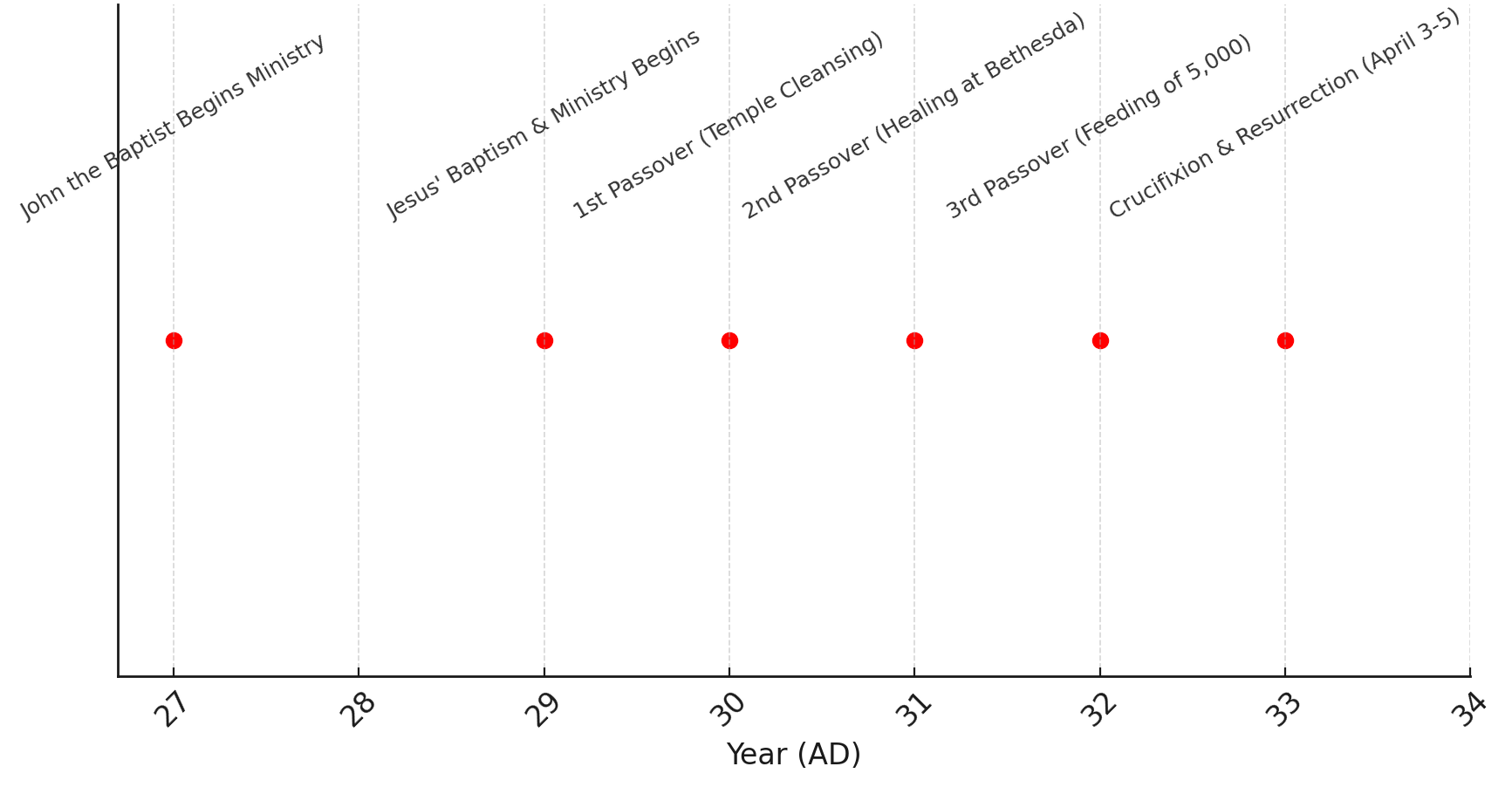70 Weeks and the King Arrives
Published on: March 14, 2025

Scholarly Analysis of Daniel 9:24-27 and Its Interpretations
Introduction
Daniel 9:24-27 is one of the most debated passages in biblical prophecy. It provides a timeline concerning the coming of the Messiah, His atoning work, and the destruction of Jerusalem. Various interpretive frameworks have emerged, including:
- Liberal (historical-critical)
- Traditional (Messianic-historical)
- Dispensational (Futurist)
- Symbolic (Theological-allegorical)
This article will examine these views, comparing them against biblical, astronomical, archaeological, and historical data to determine the best-fitting interpretation.
The Text of Daniel 9:24-27 (ESV)
Daniel 9:24-27, ESV
Seventy weeks are decreed about your people and your holy city, to finish the transgression, to put an end to sin, and to atone for iniquity, to bring in everlasting righteousness, to seal both vision and prophet, and to anoint a most holy place.
Know therefore and understand that from the going out of the word to restore and build Jerusalem to the coming of an anointed one, a prince, there shall be seven weeks. Then for sixty-two weeks it shall be built again with squares and moat, but in a troubled time.
And after the sixty-two weeks, an anointed one shall be cut off and shall have nothing. And the people of the prince who is to come shall destroy the city and the sanctuary. Its end shall come with a flood, and to the end there shall be war. Desolations are decreed.
And he shall make a strong covenant with many for one week, and for half of the week he shall put an end to sacrifice and offering. And on the wing of abominations shall come one who makes desolate, until the decreed end is poured out on the desolator.
Interpretations of Daniel 9:24-27
| Aspect | Liberal (Montgomery) | Traditional (Pusey) | Dispensational (Seiss) | Symbolical (Leupold) |
|---|---|---|---|---|
| General View | Maccabean fulfillment with Antiochus IV Epiphanes | Christ’s first coming, His crucifixion, and destruction of Jerusalem | Christ’s first coming with a future 70th week (Tribulation) | Spiritual fulfillment, not tied to exact history |
| Messiah’s Arrival | Onias III, a high priest | Jesus Christ around AD 27-33 | Jesus after 69 weeks, 70th week delayed | Jesus spiritually, not an exact year |
| Destruction of Temple | Antiochus IV, 167 BC | Titus, AD 70 | Titus in AD 70, but future Antichrist destruction possible | Symbolic, tied to rejection of God |
| Gap Between 69th & 70th Week? | No gap, all past | No gap, continuous | Yes, gap before Tribulation | No gap, symbolic |
| Best Fit for Biblical, Astronomical, and Historical Data? | ❌ Weak | ✅ Strongest | 🔶 Moderate | 🔶 Moderate |
Why the Traditional View Best Fits
-
Biblical Alignment ✅
- Messiah's cutting off (Dan. 9:26) perfectly aligns with Jesus' crucifixion.
- Destruction of Jerusalem (AD 70) fits prophecy accurately.
-
Historical & Astronomical Evidence ✅
- Decree in 457 BC (Artaxerxes I) aligns with 483 years to AD 27, marking the timeframe of John the Baptist’s ministry.
- Jesus’ public ministry began in Fall AD 29 and lasted 3.5 years, leading to His crucifixion in AD 33.
- Passover in AD 33 had a High Sabbath (John 19:31, ESV), fulfilling prophecy precisely.
- Phlegon of Tralles records a great darkness and an earthquake in AD 33.
- A lunar eclipse (blood moon) on April 3, AD 33 aligns with Peter’s reference to Joel 2:31 (Acts 2:20, ESV).
Timeline of Events Leading to AD 33

Timeline of Events
| Event | Year (AD) | Details |
|---|---|---|
| Decree to Rebuild Jerusalem (Artaxerxes I) | 457 BC | Starting point for Daniel’s 70 weeks prophecy. (Ezra 7:11-26, ESV) |
| End of 69 Weeks (483 years later) | AD 27 | Marks the time of John the Baptist’s ministry. (Luke 3:1-3, ESV) |
| John the Baptist Begins Ministry | AD 27 | Prepares the way for Jesus as prophesied in Isaiah 40:3 and Malachi 3:1. (Matthew 3:1-3, ESV) |
| Jesus' Baptism | Fall AD 29 | Beginning of Jesus' public ministry. (Luke 3:21-22, ESV) |
| 1st Passover | Spring AD 30 | Jesus cleanses the temple. (John 2:13-23, ESV) |
| 2nd Passover | Spring AD 31 | Mentioned in John 5:1 (Uncertain but probable Passover, ESV). |
| 3rd Passover | Spring AD 32 | Jesus feeds 5,000. (John 6:4, ESV) |
| Triumphal Entry (Palm Sunday) | March 29, AD 33 (Nisan 10) | Jesus enters Jerusalem, fulfilling Zechariah 9:9. (Matthew 21:1-11, John 12:12-19, ESV) |
| 4th Passover (Crucifixion) | April 3, AD 33 (Nisan 14) | Jesus is "cut off" (Daniel 9:26). Darkness covers the land (Matthew 27:45), fulfilling Isaiah 53:8. |
| Blood Moon (Lunar Eclipse at Crucifixion Night) | April 3, AD 33 (Nisan 14, 8 PM) | NASA records a lunar eclipse; Acts 2:20 and Joel 2:31 reference "the moon turning to blood." |
| Resurrection (Firstfruits Fulfillment) | April 5, AD 33 (Nisan 16) | Jesus rises from the dead on the Feast of Firstfruits. (1 Corinthians 15:20, ESV) |
Astronomical Events Supporting AD 33
Blood Moon (Lunar Eclipse - April 3, AD 33)

- Recorded in NASA’s eclipse database.
- Can be found using software such as Stellarium (Set the location and date and time to Jerusalem, April 3, AD 33 8 PM)
- Mentioned by Phlegon of Tralles, who noted an unusual darkening.
- Acts 2:20 & Joel 2:31 reference the “moon turning to blood” (ESV).
Darkness at Crucifixion
- Matthew 27:45 states a mysterious darkness covered the land (ESV).
- Phlegon of Tralles was a Greek historian and writer from the 2nd century. He incorrectly calls it an eclipse but reported:
in the fourth year of the 202nd Olympiad (AD 33), there was the greatest eclipse of the sun... and it became night at the sixth hour of the day.
- Most likely a supernatural event, as Passover occurs during a full moon, making a solar eclipse naturally impossible.
First Fruits
April 5, AD 33, is one of the commonly proposed dates for the resurrection of Jesus, which aligns with the Jewish festival of Firstfruits in that year.
What is Firstfruits?
- Firstfruits (Reishit Katzir or Bikkurim) was a Jewish festival that occurred on the day after the Sabbath following Passover.
- This was the day when the first sheaf of the barley harvest was presented to God in the temple as a sign of gratitude and trust that the full harvest would come (Leviticus 23:9–14).
- In Christian theology, Jesus' resurrection is comfortably linked to Firstfruits, based on:
1 Corinthians 15:20 (ESV)
But now Christ has been raised from the dead, the firstfruits of those who have fallen asleep."*
Was April 5, AD 33, the Date of Firstfruits?
- Many scholars, including astronomers and biblical historians, argue that Jesus was crucified on Friday, April 3, AD 33 (Nisan 14).
- If this date is correct, then Sunday, April 5, AD 33 (Nisan 16), would indeed be Firstfruits.
- This aligns with the idea that Jesus, rising from the dead on Sunday, April 5, AD 33, fulfilled the symbolism of Firstfruits as the first among those resurrected.
- In the Pharisaic tradition (which later influenced Rabbinic Judaism), Firstfruits was always on Nisan 16 (fixed).
Old Testament Prophecies of the One Who Prepares the Way for Christ
Several Old Testament passages predict the coming of John the Baptist, who was the forerunner of Christ:
Isaiah 40:3-5 (ESV)
A voice cries: 'In the wilderness prepare the way of the Lord; make straight in the desert a highway for our God. Every valley shall be lifted up, and every mountain and hill be made low; the uneven ground shall become level, and the rough places a plain. And the glory of the Lord shall be revealed, and all flesh shall see it together, for the mouth of the Lord has spoken.'
Fulfilled in Matthew 3:1-3, where John the Baptist is identified as the voice preparing the way for Christ.
Malachi 3:1 (ESV)
Behold, I send my messenger, and he will prepare the way before me. And the Lord whom you seek will suddenly come to his temple; and the messenger of the covenant in whom you delight, behold, he is coming, says the Lord of hosts."
Jesus himself refers to this prophecy as fulfilled in Matthew 11:10, where He identifies John the Baptist as the messenger.
Malachi 4:5-6 (ESV)
Behold, I will send you Elijah the prophet before the great and awesome day of the Lord comes. And he will turn the hearts of fathers to their children and the hearts of children to their fathers, lest I come and strike the land with a decree of utter destruction.
Jesus explains in Matthew 17:10-13 that John the Baptist came in the spirit of Elijah, fulfilling this prophecy.
Psalm 118:26 (ESV)
Blessed is he who comes in the name of the Lord! We bless you from the house of the Lord.
Quoted in John 12:13 during Jesus’ triumphal entry, where the people recognized Him as the Messiah.
Zechariah 13:1 (ESV)
On that day there shall be a fountain opened for the house of David and the inhabitants of Jerusalem, to cleanse them from sin and uncleanness."
This prophecy relates to John’s call for repentance through baptism in Luke 3:3.
Scholarly Analysis of Daniel 9:24-27 and Its Interpretations
Dual Fulfillment: Synchronizing the Traditional and Dispensational Views
Biblical Pattern of Dual Fulfillment
Throughout the Bible, many prophecies have both near-term and far-term fulfillments, often referred to as types and antitypes. This pattern allows for:
- A historical fulfillment in the immediate or near future.
- A final, eschatological fulfillment in the end times.
Some examples include:
- Isaiah 7:14—A prophecy about a child being born, partially fulfilled in Hezekiah’s time but ultimately in Jesus (Matthew 1:22-23).
- The Abomination of Desolation (Daniel 11:31, 12:11)—Partially fulfilled by Antiochus IV Epiphanes (167 BC), but later referenced by Jesus (Matthew 24:15) as yet to come.
- The Day of the Lord (Joel 2:28-32)—Peter partially applies it to Pentecost (Acts 2:16-21), but it also points to a future tribulation event.
Applying Dual Fulfillment to Daniel 9:24-27
By using this approach, we can synchronize Pusey’s Traditional view and Seiss’s Dispensational view:
| Aspect | First Fulfillment (Past - Traditional View) | Second Fulfillment (Future - Dispensational View) |
|---|---|---|
| Messiah’s Arrival | Jesus' baptism (AD 29) | Second Coming of Christ |
| Messiah Cut Off (9:26) | Jesus' crucifixion (AD 33) | Rejection of Christ in the Tribulation |
| The People of the Prince | Romans under Titus (AD 70) | A future revived empire (Antichrist’s kingdom) |
| Destruction of the Temple | The Roman destruction of Jerusalem (AD 70) | A future temple desecrated in the end times |
| Firm Covenant (9:27) | Jesus establishing the New Covenant (Luke 22:20) | Antichrist making a false covenant with Israel |
| Midst of the Week (3.5 years) | Jesus’ ministry lasting 3.5 years (AD 29-33) | Antichrist breaking the covenant after 3.5 years |
| Sacrifice Ceases (9:27) | Jesus' atoning death ending the need for sacrifice | Future Antichrist stopping temple sacrifices |
| Abomination of Desolation | The Roman desecration of the Temple (AD 70) | The Antichrist setting up an idol in the temple (2 Thess. 2:4) |
| Completion of 70 Weeks | The Gospel going to the Gentiles (AD 34) | Final redemption at the Second Coming |
Key Benefits of This Approach
-
Resolves the Gap Issue:
- The first half of the 70th week (3.5 years) is fulfilled by Jesus' ministry (AD 29-33).
- The second half (3.5 years) is the Great Tribulation, which is still future.
-
Explains Jesus' Covenant & Antichrist’s Treaty:
- Jesus fulfilled Daniel 9:27 spiritually, but Antichrist will “counterfeit” it in the future.
-
Harmonizes the Prophecy with Revelation:
- Revelation describes a 3.5-year period of tribulation (Rev. 11:2, 12:6, 13:5), matching the second half of Daniel’s 70th week.
Conclusion
The Traditional (Pusey) interpretation provides the most accurate alignment of biblical prophecy, historical events, astronomical evidence, and archaeological findings. This information shows God's absolute sovereignty over his creation including time itself.
✅ AD 33 as the year of Jesus' crucifixion is the strongest fit because:
- Daniel’s 70 Weeks calculation (457 BC → AD 27 for John, crucifixion in AD 33).
- The High Sabbath (Passover & Weekly Sabbath overlap) fits John 19:31 (ESV).
- Astronomical events (blood moon, darkness, High Sabbath) confirm historical records.
- The destruction of Jerusalem in AD 70 precisely fulfills Daniel 9:26 (ESV).
- Resurrection day April 5, AD 33 was the feast of Firstfruits. This aligns with Leviticus 23:9–14 and 1 Corinthians 15:20
Duel Fulfillment
The dual fulfillment approach allows us to synchronize the Traditional (Pusey) and Dispensational (Seiss) interpretations by:
- Recognizing Jesus' ministry as the first fulfillment.
- Allowing for a future tribulation that completes the prophecy.
✅ Jesus' atonement fulfills Daniel 9:24-27 historically, while the Antichrist’s actions will echo these events in the final tribulation.
This approach aligns with the biblical pattern of shadows and types, providing a balanced interpretation that integrates both views without contradiction.